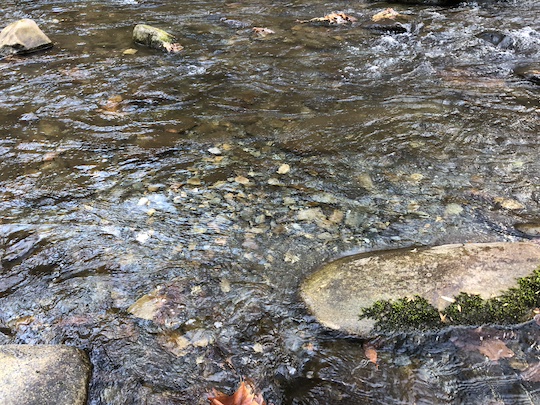There are tons of opinions on whether you should be fishing during the spawn. Some states solve the problem by having closed seasons for trout fishing. Many other states do not, leaving anglers to come to terms with their own set of ethics. Here in Tennessee and in the Great Smoky Mountains, we are fortunate to be able to fish year round. That helps keep the cabin fever at bay during the cold months, but also makes it important to figure out your own set of ethics when it comes to fishing or not fishing the spawn and the time periods around it.
Often, it seems irrelevant as to whether it is "okay" to fish during the spawn or not, but a variety of factors the last few years has led to a huge decrease in the number of large trout on many area waters. From the Clinch River wild rainbows and big brown trout, to the big browns on the Caney Fork, to the wild browns in the Great Smoky Mountains, numbers of larger fish are down across the board. While the overall reasons behind that decrease may or may not be angler driven, the fact remains that we have lower numbers of fish. Thus, it is more important than ever that the fish be allowed to procreate in peace. That is the place I'm at. You may arrive at something different. That is okay, but if you want to do what's best for the fish, read on.
Choosing to fish (or even guide) around the spawn immediately brings a new set of challenges. How do you fish water that fish are spawning in without interrupting that process? To some extent, interruptions will happen no matter how careful you are. In my opinion, other than not fishing to actively spawning fish, the most important thing you can do is to watch your step. The precious eggs, once distributed into the gravel, are vulnerable to a misstep. In fact, just once misstep could kill nearly all the eggs in one redd. Thus, you now have a couple of options. Either avoid fishing and wading altogether during the spawn, OR learn what to look for and avoid redds at all costs.
If you choose the latter, here is what you should look for. Brown trout redds are usually depressions and accompanying mounds in the gravel in riffles and tailouts of pools. I've seen redds in all kinds of water, but most will be in the riffles and tailouts. However, the most important thing is gravel. On some streams, good spawnable (did I make up a word?!?!) gravel is hard to find. It appears easiest to learn what kind of gravel is good for spawning and simply avoid walking on all gravel that is similar. In actual practice, it is helpful to be able to identify redds and walk on gravel when possible, because gravel is often going to be your best traction in the stream.
To understand what a redd looks like, first you should understand how the redd is built. First, the female finds the perfect site for her nest. Next, she begins to fan with her tail to dig out a depression. That depression is where she will lay her eggs. Once she has prepared the nest, she lays some or all of her eggs while a dominant male delivers milt to fertilize the eggs. Then, she will move just upstream and stir the gravel again, allowing the current to filter the gravel down onto the eggs to protect them. This small mound that forms is where the actual eggs are stored. Some fish may repeat this procedure several times leaving an area well stirred up, while others may make a single redd and call it quits. This process applies to rainbows and brook trout as well. Once those eggs are laid in the gravel, it is crucial for anglers to avoid stepping on the nests. Each generation will often see a fairly low success rate, so we need every nest to stay viable if possible.
The incubation periods can vary wildly depending on water temperatures. Long periods of 4-5 months at a constant 35 degrees Fahrenheit down to a very short 30 days at 57 degrees Fahrenheit mean that it depends on the weather and stream as to how long it takes for the eggs to hatch. In the Smokies, most of our eggs will typically hatch sometime in January into February in a normal year and depending on exactly when they were laid. For fish that spawn in late October or early November, it is possible that same hatch by early January, while late spawning fish in late November into December may not have eggs hatching until closer to March.
Other than anglers, extreme cold and anchor ice can disrupt the viability of the spawn. Extreme flow events with high water can also disrupt the process. Finally, on our tailwaters, low dissolved oxygen is also a major limiting factor to successful brown trout spawning.
If you have read this far, then you clearly care deeply about the health of our wild fisheries. While everyone needs to make their own decisions as to whether to fish the spawn or not, I hope you will at least be very careful as to where you walk during the fall through spring period. The health of our fisheries depends on anglers being careful. Here are several examples of brown trout redds in the Smokies from the past few weeks. Note how redds often appear as bright patches in an otherwise darker bottom.
If you have any questions or want some better pictures, feel free to contact me using the information from the contact link above. I'm always glad to help promote the health of our fisheries.






